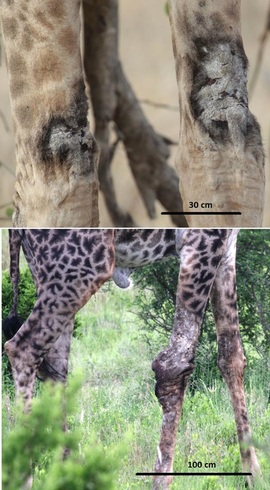 New research from Wild Nature Institute scientists published today in the Journal of Wildlife Diseases documented giraffe skin disease (GSD) occurrence and prevalence across protected areas of northern Tanzania. Giraffe skin disease is a disorder of the skin that is characterized by crusty lesions on the posterior forelimbs of adult Masai giraffe (Giraffa camelopardalis tippelskirchi) the only subspecies in Tanzania. Dr. Derek Lee, lead author of the study, said, "Quantifying regional prevalence of giraffe skin disease will help identify hot spots and possibly disease-free refugia, as well as potential environmental risk factors and transmission corridors. This is the first step in our ongoing investigations into this emerging disease." The disease was first reported in 2000 in Ruaha National Park in central Tanzania. The study found a disjunct distribution of giraffe skin disease prevalence that was best explained by soil type. If parasites such as nematodes or tsetse flies are involved in giraffe skin disease, differences in soil may influence ground-dwelling life stages. Soil characteristics may also impact the nutritional status of giraffes through vegetation quality, thereby altering their susceptibility to giraffe skin disease. Learn more about Wild Nature Institute's Masai giraffe research and conservation work at www.wildnatureinstitute.org/giraffe.html
0 Comments
Your comment will be posted after it is approved.
Leave a Reply. |
Science News and Updates From the Field from Wild Nature Institute.
All Photos on This Blog are Available as Frame-worthy Prints to Thank Our Generous Donors.
Email Us for Details of this Offer. Archives
July 2024
|
|
Mailing Address:
Wild Nature Institute PO Box 44 Weaverville, NC 28787 Phone: +1 415 763 0348 Email: [email protected] |
|

 RSS Feed
RSS Feed
